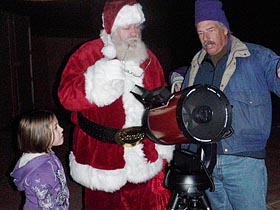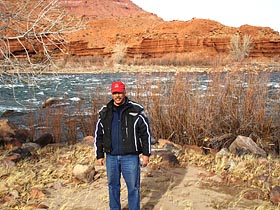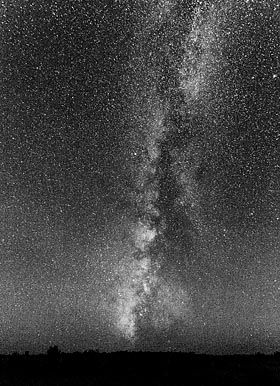| Your Astronomy Trip What to expect on your trip What you may see |
| YOUR DAY TRIP |
| YOUR GUIDE |
| RATES & RESERVATIONS |
| FAQs |
| COMMENTS & LETTERS |
| HOME |



Courtesy of F. Nicholas, U.K.,
visitor 2012
| Your Astronomy Trip What to expect on your trip What you may see |
| YOUR DAY TRIP |
| YOUR GUIDE |
| RATES & RESERVATIONS |
| FAQs |
| COMMENTS & LETTERS |
| HOME |



Courtesy of F. Nicholas, U.K.,
visitor 2012

FAQs
When can I go on a trip?
Trips are available year round. Stargazing trips typically begin at sundown. As a rule, we want fairly clear skies and ideally, not a lot of moon. There are several days every month that we term the “dreaded mooned-out period” when it is just too bright to do any night time viewing! Check the “MOONED OUT” calendar (found on the Rates Page). Trips are held in the winter also, as there can be wonderfully clear skies during that time. I provide a small heater when it is cooler weather so everyone can stay warmer while viewing.
Will there be other people viewing with us?
Many times you will be viewing with just the individual members of your own group, as I will take as few as two people on a trip. At other times, though, it is possible you may be with others that are in town during the same time frame and would also like to go on a tour. On a normal trip, the maximum number of guests is held to 12 (occasionally an extra youngster)! This is to maximize the viewing/Q & A time for each guest. The group on your trip may consist of couples, families, singles, etc.!
Special, EXCLUSIVE nights can be arranged for larger groups with advance notice.
What time do the trips start and how long do they last?
We typically meet for the trip around sundown, so the time changes by season. It can be as early as 5:00 or as late as 9:00. As a rule, most tours last from 1 1/2 to around 2 hours at the viewing site. (Drive to and from the viewing site is another 20 – 25 minutes each way).
Where are the trips held?
We are permitted for many dark sky locations on public lands near Moab, including some campsites. My favorite location is an easy 20 minute drive from Moab between Canyonlands NP and Arches NP.
What will I see?
We will be seeing a variety of objects, depending on what is visible for that particular time of year. Planets in our solar system are always a favorite, especially Saturn and Jupiter, when they are up. We will view Star Clusters, Galaxies, and Nebulae, among other things!
What do these objects look like?
Seeing objects in the heavens in real life and time is quite different than just seeing a photograph. Images that are from the Hubble Space Telescope or from an astronomy photographer will appear much different than the sights we will actually see because they may photograph over days or weeks and usually add color to enhance the image. Far away Galaxies and Nebulae have a wispy, ethereal quality that can lack the color of a photograph, but are quite beautiful. Planets such as Jupiter and some of the stars, on the other hand, reveal colors that can be thrilling to view. Saturn with its rings is a great favorite.
What kind of equipment do you use?
Nothing but the best! The telescopes I use are Meade and Celestron. My eyepieces are Televue and Celestron, and I use Feathertouch focusers.
I provide comfortable chairs, a step stool to assist viewing for the vertically challenged, and blankets or heater(s) during cooler weather.
What happens if we get cloudy or inclement weather?
I always watch the weather carefully. There are often clouds right around sunset that clear up shortly thereafter. I will usually wait until the very last minute to cancel, if it becomes necessary. I always try to have folks pick a 2nd night as an alternate so no one misses out as long as I have space available on the alternate night. If we proceed with the trip and the conditions worsen, you will pay for only the time spent viewing, i.e., ½ trip = ½ trip charge, no viewing = no charge.
Do you provide transportation to the viewing site?
No, I do not provide the transportation. Instead, we will meet at a mutually agreed time and site and you will follow me to the viewing site, typically around 20 - 25 minutes from town. This way, when the tour is over, you will be able to leave when you are ready and not have to wait while I tear down the equipment!
What should I wear on the trip?
Dress comfortably with good shoes. I always recommend you dress in layers and bring a jacket or sweater, gloves, and some sort of head cover during cold times. The temperature can drop rapidly and it is always better to be prepared. You can bring some water or beverages with you, along with some snacks if you would like. Also, blankets in colder weather can be nice, although I do supply a limited number.
What is your background?
I have lived in the Four Corners region for most of my life and have always enjoyed nature and the outdoors. My interest in telescopes and the cosmos started at an early age, where often times I would sleep on our roof to view the stars overhead. My astronomy education is ongoing every year and of course, I get lots of viewing time! (for more about Alex, see “Your Guide” page)
The MOST IMPORTANT thing for me is to share and teach an appreciation for our special area. This is my 25th year guiding the rivers, canyons, mountains and the cosmos of the southwest!